Kickstarter Tabletop Alert: ‘Adventure Party’ Is a Critical Hit
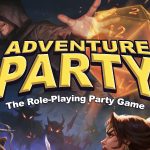
How well do you know your fellow adventurers? This party game will put you to the test!
What Is Adventure Party?
Adventure Party is a cooperative role-playing party game for 3 to 8 players, ages 14 and up, and takes about 30 to 60 minutes to play. It’s currently seeking funding on Kickstarter, with a pledge level of $35 for a copy of the game, or $80 for the deluxe pledge that includes custom dice and the first expansion. Although the game is recommended for 14 and up, I think kids who love telling stories—especially if they have any familiarity with the traditional swords-and-sorcery role-playing worlds—can join in.
Adventure Party was designed by David Smith and Travis Winstead of Winsmith Games and published by Smirk & Dagger Games, with illustrations by Grafit Studio.
New to Kickstarter? Check out our crowdfunding primer.
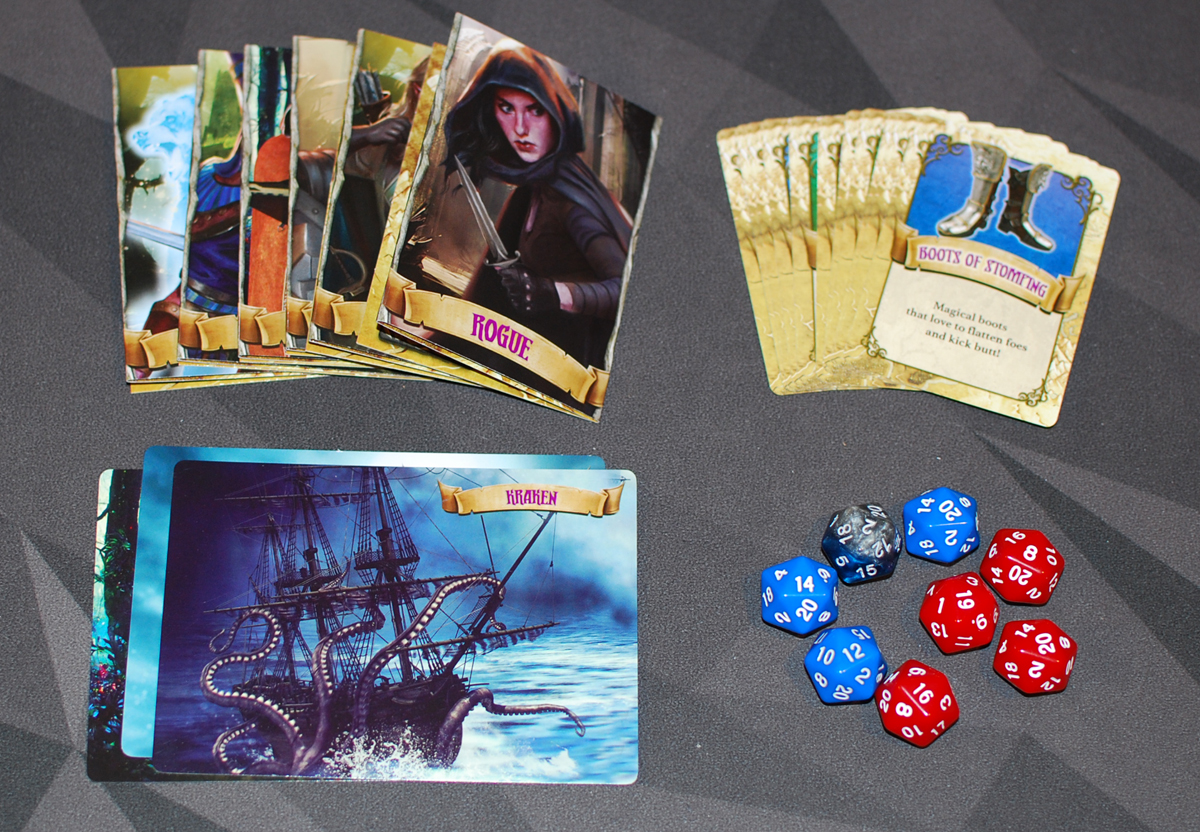
Adventure Party Components
Note: My review is based on a prototype copy, which had a smaller subset of components. The dice pictured are my own, but the finished game will have different colored dice for each player. The list of components below may also increase based on stretch goals, but is current as of this writing.
The finished game will include:
- 9 Character screens
- 8 20-sided dice
- 42 Magic Item cards
- 26 Adventure cards
- XP tokens
- Glory tokens
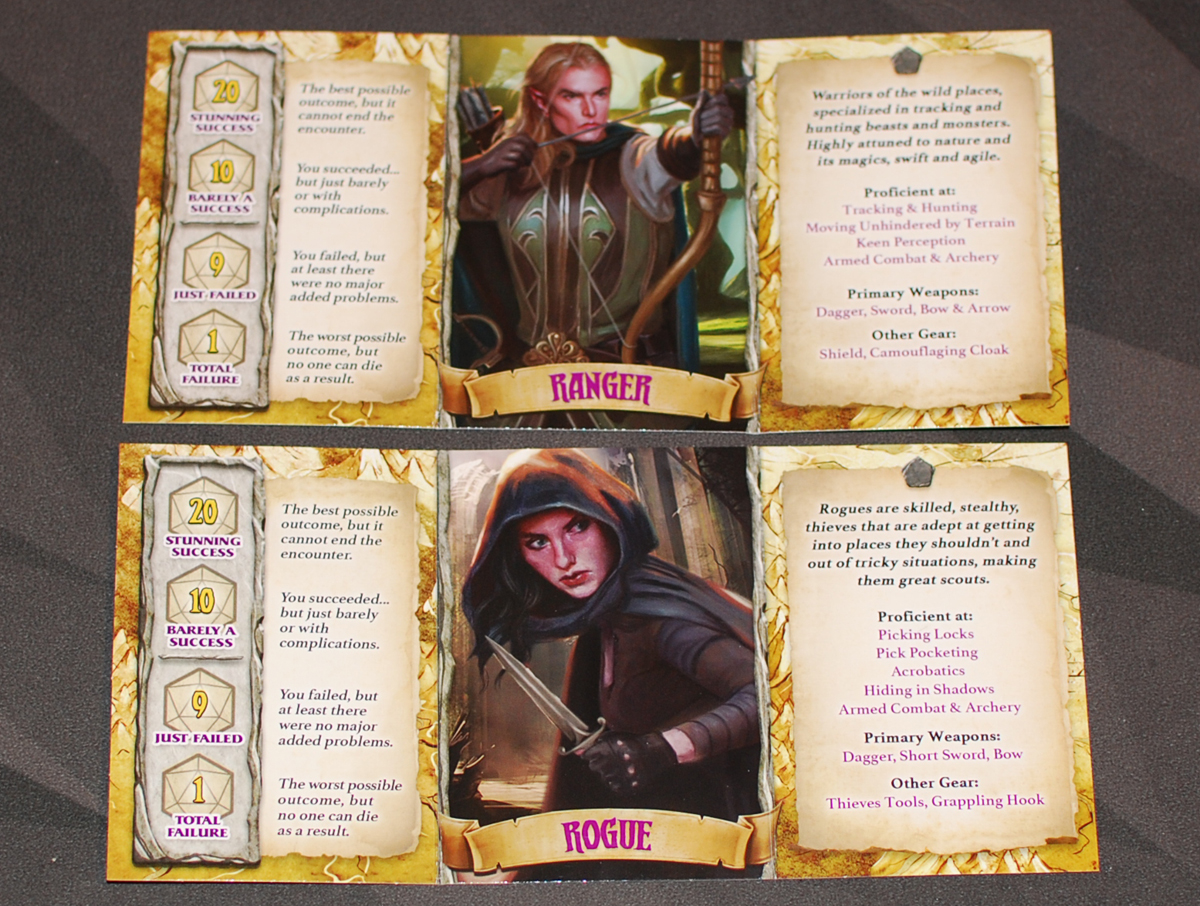
The character screens are small tri-fold screens that have a character portrait on the outside, and then some player aids on the inside—a reminder of what your roll could mean, and some skills and items that your character can use. They’re used to hide your die roll from other players, though you’ll need to hold them in place if you’re going to roll the die against them or it’ll just knock them over.
The magic item cards include things like the Hammer of Smashiness, the Horn of Summoning, and the Armlet of Blasting. Each one has an illustration and a brief description of what it can do. Role-playing fans may notice that there aren’t any stats on these (or on the character screens)—but you’ll see why. These items are more for the narrative flavor rather than adding or subtracting specific values from a die roll.
The adventure cards are oversized cards, each with a short description of a scenario and sometimes a few optional setup instructions. There’s also a nice illustration to help set the scene.
How to Play Adventure Party
You can download a copy of the rulebook here.
The Goal
The goal of the game is to score experience points (XP) as a party by correctly guessing each other’s rolls.
Setup
Give each player a character screen, a die, and two magic item cards. Everyone rolls their die, and whoever rolls highest will serve as the first Guess Master (GM).
Gameplay
The GM draws the first adventure card and reads it aloud. The player to their left will be the first active player.
The active player rolls the die behind their screen. Then, based on the die roll, they will describe their action, including one of their magic item cards, and the results of their action. In case you’re not familiar with role-playing games, a “1” is an epic failure, the worst possible outcome, and a “20” is a critical hit, where everything you did goes right. In the middle, a 9 is just barely a failure, and a 10 is just barely a success. In Adventure Party, note that with a “1” none of the players can be killed (though you can be injured), and a “20” can’t end the scenario entirely because everyone needs to have a turn. Your aim as a player is to describe your action so that the other players can guess where your roll fell on a scale from 1 to 20.
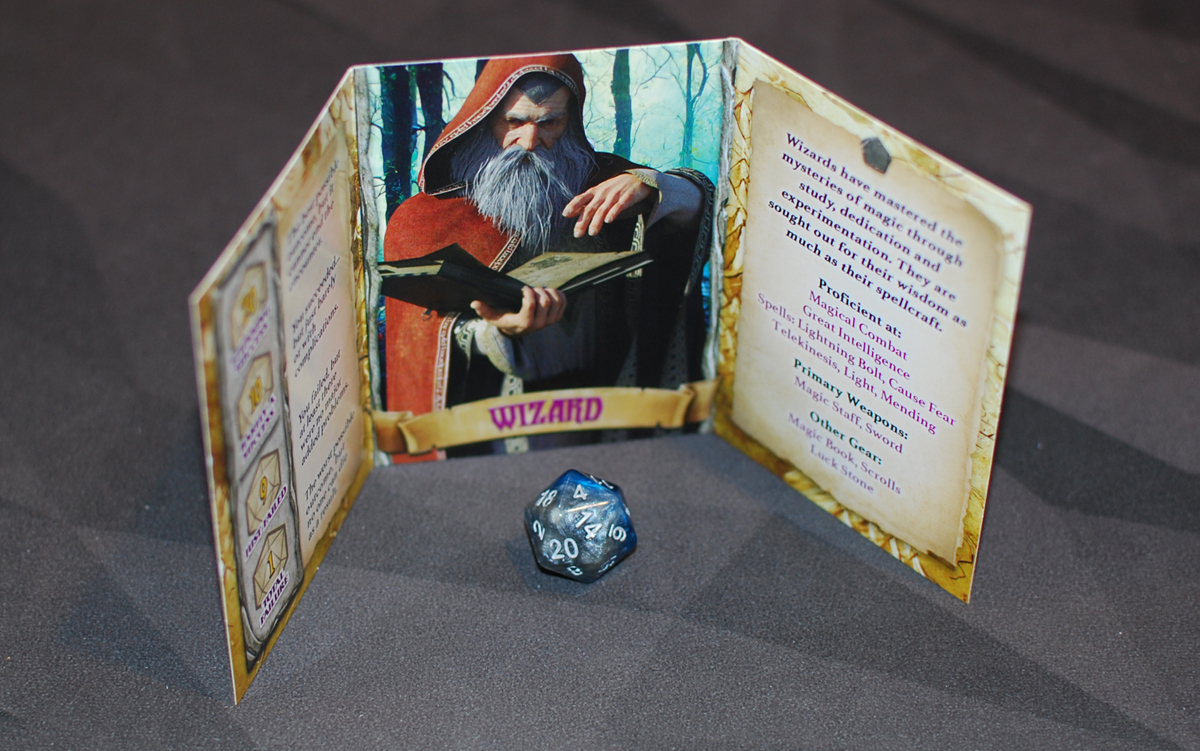
Once you’ve described the results, the GM may ask one clarifying question, allowing you to elaborate with some additional details. Then, all players secretly set their dice behind their screens to indicate what they think the active player rolled. When everyone has set their guess, the screens are removed and the dice are revealed.
The GM’s guess earns XP for the party as a whole: you earn 5 XP if the guess is exactly correct, subtracting one point for each number away from the actual roll. So if the actual roll was a 13 and the GM guessed 15, they would earn 3 XP. (If you’re more than 5 away from the roll, you earn 0 XP.)
The rest of the players can earn glory points for themselves: 2 glory if your guess was correct, and 1 glory if you were 1 away.
Then, the player who just completed their action becomes the new GM, and it’s the next player’s turn.
After everyone has had a chance to be the active player, the last GM describes the conclusion to the adventure.
If desired, you can play another adventure—the full game is 3 scenarios for 3–6 players, or 2 scenarios for 7–8 players. Re-roll to pick the starting GM for the next adventure, discard the used items and draw new ones for everyone, and then the new GM narrates a transition from the previous adventure to the next adventure.
Game End
The game ends when all adventures are completed. Add up all of the XP earned and compare it to the chart to see how your party ranks, from Embarrassing to Legendary. The player with the most glory gets to announce the ranking, and then tell everyone how your party will be remembered for all time.
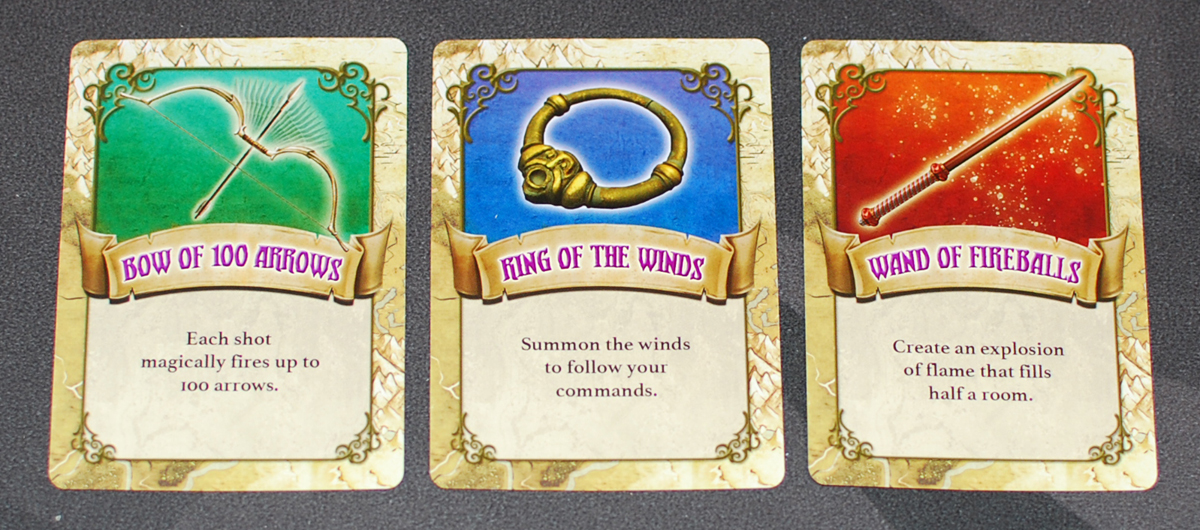
Why You Should Play Adventure Party
There’s a team-based party game from 2019 called Wavelength (which I backed on Kickstarter); you take turns giving clues so your teammates can make a guess—via a cleverly engineered dial—where the needle falls on the scale. You draw a card at random that tells you the two ends of the scale, so it could be something like “hot” to “cold” or it could be something harder like “not a sandwich” to “sandwich.” There’s a bunch of different cards, and the fun comes from the challenge of figuring out what sort of clue to give your teammates so they’ll turn the dial to 64% on a scale from “round” to “pointy.” (Bert’s head? A dull pencil?) It’s fun to see how everyone interprets your clue, and there’s a particularly satisfying feeling of triumph when somebody nails the guess exactly right.
Adventure Party has some similar vibes, where the scale is always “failure” to “success” with a range of 1 to 20, but instead of giving just a phrase or a word, you get to tell the story of your encounter with a kraken or an undead dinosaur. How do you indicate the subtle differences between rolling a 14 and a 15? The ends of the spectrum can be pretty easy to identify from the story, but when you have a middling failure or a middling success, it gets a lot trickier. Unlike an actual RPG where epic fails are to be avoided whenever possible, in Adventure Party it gives you an opportunity to tell a really funny story.
One of the things that surprised me most was how close we were able to get with our guesses. In the times I’ve played so far, we’ve had quite a few that were right on the nose, and many more that were just 1 away. (Though we did have some complete misses as well.) Everyone gets a chance to guess—the GM earns XP and the other players earn glory—so that keeps everyone engaged and thinking about it. The clarifying question can also be really useful and helps the player understand a little bit about how the GM is thinking about their story.
I mentioned that it does help to have some familiarity with RPGs, but it’s not required. I’m more RPG-adjacent myself, and I feel like I know a good bit about the main concepts, but not a lot of the specifics. The little character screens give you some pointers if you need help: for instance, you know the Druid can shape-shift into animals, but you don’t need to know anything about what’s required to cast it or what the restrictions are. Basically, if you’ve read or watched or played just about anything with a fantasy setting, you can probably imagine enough to figure out your role in the narrative.
The story-telling itself is a pretty key ingredient, though, and that’s what I think could make or break the game for your group. While you don’t all have to be amazing fabulists, there’s a difference between saying “I shoot my bow at the kraken but missed” and “I take aim with my Bow of 100 Arrows, picking just the right moment to hit the tentacle wrapped around the mast, but just as I release the string, a wave crashes over the side of the boat and my arm swings wide, sending the shots into the open sea.” Both can get the job done, and give your GM a chance to guess your roll, but the game really shines when everyone’s tales are fun to listen to. My players had a mix of experience levels with RPGs and it seemed to work well, with some stories more elaborate than others. As with many things, you can get better with practice, too—and I imagine that those who play a lot of games together will improve their ability to guess the number rolled.
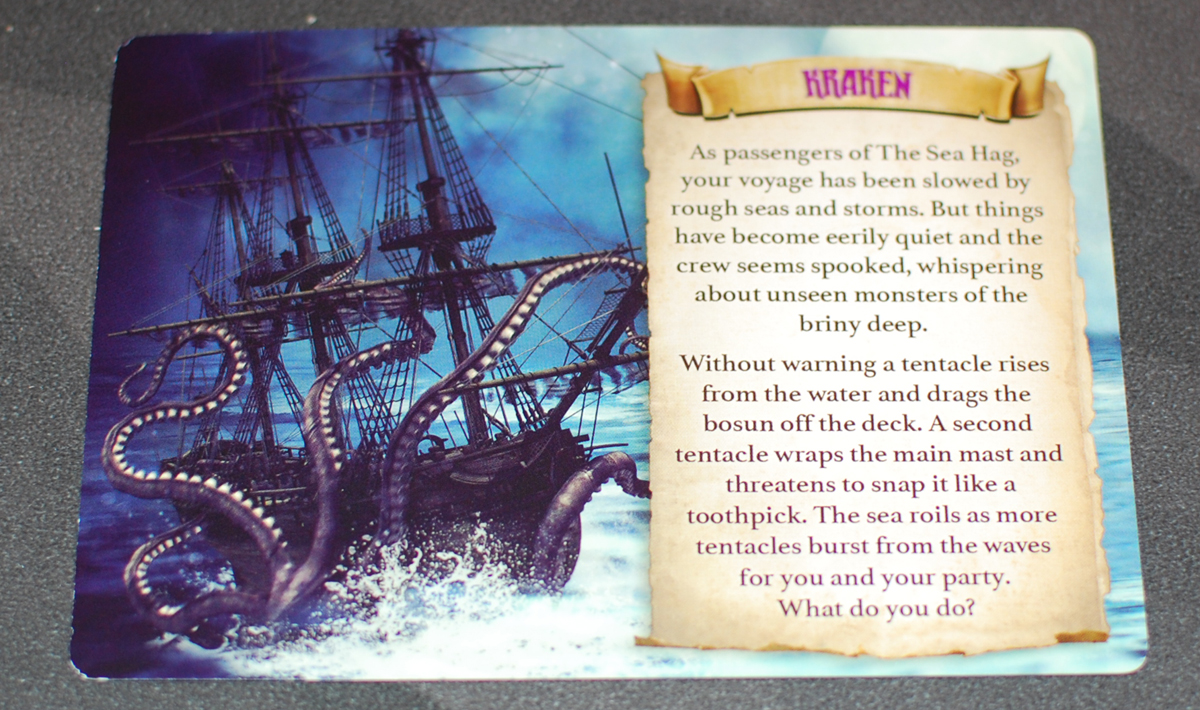
I’ve really enjoyed playing the prototype of Adventure Party so far, and am excited to see the full game (since the prototype only had three adventure cards in it). I think it’s a nice blend of role-playing and party game, and could serve as a nice entry point for people new to role-playing. My 10-year-old plays a lot of games but hasn’t really played RPGs either, so it was fun to see her exercising her improv muscles to describe her portions of the story. If your group loves telling stories and you like the RPG setting, it’s definitely worth checking out.
For more information or to make a pledge, visit the Adventure Party Kickstarter page!
Click here to see all our tabletop game reviews.
![]() To subscribe to GeekDad’s tabletop gaming coverage, please copy this link and add it to your RSS reader.
To subscribe to GeekDad’s tabletop gaming coverage, please copy this link and add it to your RSS reader.
Disclosure: GeekDad received a copy of this game for review purposes.
Click through to read all of "Kickstarter Tabletop Alert: ‘Adventure Party’ Is a Critical Hit" at GeekDad.If you value content from GeekDad, please support us via Patreon or use this link to shop at Amazon. Thanks!

